Churn Data Signals Alarm Bells for HBO Max, Success for Peacock
Churn Data Signals Alarm Bells for HBO Max, Success for Peacock

Although many observers tend to evaluate streaming services by raw subscriber numbers, perhaps the more important number to track is “churn.” Are your subscribers loyal or do they sign up to watch one show and drop the service once it’s over?
The Streamable contacted the analytics firm Antenna to get their data on churn rates to see how each major service is performing on this key metric. Here are the key takeaways.
Overall Churn is Increasing
In June of 2022, the weighted average churn rate across the industry was 4.57% as of March 2023 (the most recent data), the number jumped to 5.53%. That may not seem like a lot, but these streamers are desperate to hold onto subscribers. One who leaves is more difficult to lure back.
Why are more people dropping streamers? Price increases are a likely culprit. Almost every service has pushed through a price hike in the last year or two.
Another issue may be a tightened content pipeline. In 2021, Warner Bros. pushed all its theater-bound films to HBO Max on the same day. Disney+ experimented with a similar strategy, allowing its subscribers to pay an additional “Premier Access” fee to see brand-new movies. Disney also dumped its Pixar slate directly on Disney+, bypassing theaters directly.
“Top Gun: Maverick” appears to be the film that forced Hollywood to rethink its strategy. By holding the blockbuster until theaters reopened, Paramount scored a massive hit, racking up nearly $1.5 billion worldwide. Disney and WarnerMedia’s new CEOs seem intent on breathing life into the theatrical business with franchises galore.
With fewer films going direct-to-streaming, more users may be prompted to reevaluate their subscriptions on a monthly basis.
Overall churn reached an all-time high in January of ‘23 (6.27%) as subscribers cut back after the holiday rush of content on each platform.
Trouble for HBO Max?
HBO Max had been trending in the right direction for months, dropping from 6.88% churn in March ‘22 to a low of 4.94% in September. But that number exploded near 7% in January, and the rate is holding steady.

Remember that HBO Max started throwing lots of old content off its platform in December. The service also started showing ads in HBO Originals for the first time. This was coupled with a price hike in January. Higher prices and less content is a potent mix to reevaluate a subscription.
The service’s sister platform — discovery+ — has maintained a relatively consistent churn rate near the average for all platforms.
It will be fascinating to watch what happens with the HBO Max rebrand as “Max” later this month. Will subscribers enjoy the new Discovery content or will they be turned off by the clutter? The price is expected to remain the same, so that should tamp down a mass exodus, but WarnerMedia has a major headache on its hands if it can’t pull churn back down.
Peacock’s Winning Formula, STARZ’s Freefall
In March of 2022, no service had a worse churn rate than Peacock. A jaw-dropping 9% of its subscribers walked away that month. But Peacock has been making smart, strategic moves that pulled that number down to 5.73% a year later. Just look at this timeline of victories:
- Peacock clawed NBCU shows back from Hulu
- MSNBC provided most of its shows to Peacock
- Peacock grabbed streaming rights to some MLB games
- It added a catch-up feature for Premier League games
- Bravo shows left Hulu for Peacock
- Peacock rolled out a new user interface
- The service added U.S. Softball National Team games
- Peacock pulled “30 Rock” back from Netflix
- “Days of Our Lives” became a Peacock exclusive
- “Halloween Ends” debuted on Peacock on the same day it hit theaters
- Peacock added some 4K titles
- The service announced it would stream IndyCar events
- Peacock announced it would stream Supercross and Pro Motocross races
- The service announced it would air World Cup games in Spanish
- It added a Hallmark Movie hub with live channels, on-demand films and series
- Peacock added a stream of local NBC affiliates in 210 markets for Premium Plus subscribers
- The service announced it would carry NBC regional sports networks in some markets
- Peacock announced plans to televise every NBC/GOLF Channel PGA Tour event, the LPGA followed
- The service acquired rights as the Spanish-language streaming home of U.S. Men’s and Women’s National Team soccer
- Peacock dropped its free tier for new subscribers, it also ended free access for Xfinity subscribers
- Peacock grabbed streaming rights for the 2024 Tour de France
- The service added the popular Reelz channel, home of “On Patrol: Live”
- More MSNBC shows joined the service
- Meta Quest VR users can now watch Peacock on their devices
- The service added films from Magnolia Pictures
Simply put, Peacock has gotten better every month, adding new content appealing to multiple audiences, and clawing back content from other partners. The service has also offered dozens of discounted deals over the past few months. That’s a recipe for success.

On the contrary, STARZ can’t stop the bleeding. The service is struggling as its churn rages out of control. In an inverse of Peacock, STARZ’s churn ran from 5.89% in March of ‘22 to 9.21% a year later.
If you take advantage of a free trial of the service, you’ll see why. The library is painfully thin, and it’s not offering the same variety and pace of new content as its competitors. Unless something changes, STARZ could be the first streamer to collapse.
Paramount+ and Showtime Keep Struggling
Paramount Global has been making moves to shore up its two streamers, but both are struggling with a churn that remains well above average.

While Paramount+ is great if you enjoy the shows on the platform, its movie library contains a lot of lackluster titles and navigation is less than optimal. While we appreciate the ability to add Showtime to the service, Showtime became a lot less valuable as the company killed off several original shows. A price hike gave fuel to any subscribers who were thinking of leaving.
Curiously, Paramount is not keeping its content within its platforms. As of this writing, the six original Star Trek movies and all four “Next Generation” Trek movies are on HBO Max, not Paramount+. Only two Transformers movies are on Paramount+. The Godfather Trilogy is a Paramount property, but you won’t find it on the platform. When the movie library is thin to begin with, those decisions are head-scratchers.
While Paramount+ is home to the popular Taylor Sheridan shows like “Tulsa King” and “1923,” Paramount+ isn’t ramping up production for enough other shows to keep people entertained. One episode of one show per week won’t keep people subscribed. After taking a 25% beating to the stock last week, you can bet Paramount’s leadership is feeling the heat.
Netflix, Disney+, and Hulu: Old Reliables
If you’re looking for the companies really winning the streaming wars, it’s the biggest players: Netflix and Disney’s twin streamers.
Netflix limbos well below the average churn rate, hanging down around 3%. Despite several changes to the platform, subscribers stick with the original streamer. It helps that Netflix keeps churning out crowd-pleasing hits. Movies like “The Adam Project” (March ‘22), “The Gray Man” and “Purple Hearts” (July), “Glass Onion” (December) all cracked Netflix’s Top 10 Most-Watched list.
Over the same time, Netflix gained three new shows in its Top 10 Most-Watched: “Wednesday,” “Monster: The Jeffrey Dahmer Story,” and “The Night Agent.”
If there’s a narrative that Netflix is slipping, the numbers don’t support that.

Disney+ and Hulu suffered a wave of defections in November. Some of that may have been related to the Disney+ price hike for the ad-free plan. Another factor is that Hulu traditionally offers its best deal of the year for Black Friday, so people who were part of 2021’s annual deal may have abandoned the service when their package expired.
Whatever the reason, both Disney+ and Hulu quickly pulled back under the average churn rate, putting it in great shape. Recent churn is higher than the same months one year ago, but that seems to be a trend across the industry.
Get Disney+, Hulu, and ESPN+ for just $16.99 a month ($14 savings).
Apple TV+ Price Hike Increases Churn
In late October, Apple TV+ announced one of the biggest price hikes in streaming history with a 40% jump. As you can see, that sent subscribers fleeing. The service’s churn rate leapt from the 5% range to beyond 7%

It’s no wonder Apple TV+ took a hit. The service is a nice-to-have, but not need-to-have addition. While we love some of the shows on the platform, it has an incredibly slow pipeline. “Ted Lasso” and “Severance” are gems, but that price increase forced people to take a harder look at their streaming budgets.
Conclusion
While churn is a way of life for any company in the subscription business, the providers who continue to innovate and add value will earn loyalty, while penny-pinching companies or those with stagnant content lineups will face the consequences.
While WarnerMedia may crow about righting its financial ship, HBO Max subscribers are showing clear signs that the cost-cutting is making the service less attractive.
Peacock benefits from a lot of fantastic, strategic moves over the past year. In some cases, it’s just a matter of regaining rights to content previously leased elsewhere. But the value of the service continues to grow. Users hardly blinked when the free tier disappeared, in part because Peacock was doing so well with its paid offering.
It’s not enough to spit out a new streaming service and expect people to sign up. The audience is now more discerning. With inflation taking a toll in other areas, the streaming budget is an easy place to cut back. As free providers like Tubi, Roku Channel, and Pluto TV improve their offerings, some previous SVOD subscribers are discovering the benefits of ad-supported entertainment.
We’ll continue monitoring churn as it evolves, but we know that number will jump in conjunction with any price hike. And we know the folks over at Lionsgate (STARZ’s owner) are probably having a lot of sleepless nights.
